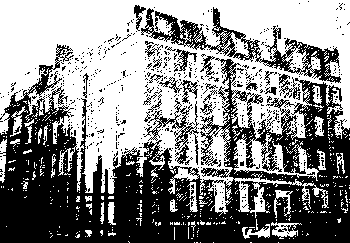Suitable for all ages |
Camden Leisure & Community |
John McKean Brydon, architect
J. M. Brydon (1840-1901) was so proud of his design for Chenies Street
Chambers that it was mentioned in his obituary and his widow presented the
plans to it to the Ladies Dwellings Company. The plans have been lost (since
the building was rebuilt by Camden Council in 1947, they may still turn up
someday).
J.M. Brydon also designed two other important women's buildings for the Garrett's
suffragette circle: the Hospital for Women (opened 1890) in Euston Road,
and the London School of Medicine for Women (opened 1898), in Hunter Street
near Brunswick Square. He probably became familiar with the Garrett circle
because he was trained by J.J. Stevenson (Stevenson's first wife was Elisa
Anderson, the cousin of Skelton Anderson, husband of Elizabeth Garrett Anderson;
Stevenson's brother Archibald married Skelton's sister Margaret Jane). In
1873-74, Brydon completed the training of Elizabeth's sisterAgnes and and
her cousin Rhoda Garrett at his home and office at 39 Marlborough Street,
after they left the appenticeship of Cottier & Co. He also supported
Ethel and Bessie Charles in their bid to be the first women architects admitted
to RIBA.
Chenies Street Chambers (9 Chenies Street) was originally built in 1888,
pre-dating both these buildings. The incorporation of the Ladies Dwellings
Company (LDC) took place on 16 March 1888 and the first recorded meeting
was on 27 March, 1888 at Millicent Fawcett and Agnes Garrett's home, 2 Gower
Street, attended by Agnes Garrett, Christiana Herringham, Anne Townsend and
Giles Picher. The minutes for 12 April 1888 report that the architect, John
Brydon, had accepted a tender from Messrs Brass & Son for the building
of a block of chambers on a site owned by the Bedford Estate. Brydon received
£475 for his fee.
The building was opened by Agnes's sister, Millicent Fawcett, on 20 May 1889 and the opening was reported in the Englishwoman's Review, 15 June 1889. Chenies Streeet Chambers proved to be so popular that, when the adjoining land in Huntley Street became available, (nos. 3,5 & 7), it was acquired for a substantial addition to the building in 1896-97, extending the building from the Trademan's Entrance further north along the west side of Huntley Street. This increased the number of sets of rooms in Chenies Street Chambers from 22 to 37. (This extension explains the increase in listed occupants between the 1891 and 1901 census).

Chenies Street Chambers, south-east corner of building showing Huntley Street extension, unknown date. Note the changed roof line to the extension. From Chris Coates' Utopia Britannica.
When he
built the extension, Brydon also built a new dining room in the basement,
which was decorated with two pairs of handsome marble pillars. The four panels
of angels sculpted by Ellen Mary Rope (1855 - 1934) were placed over the
two fireplaces of the dining room and in the intervening alcoves. (The minutes
of November 1997 record that 'the sum of £12.10.0 be paid to Miss Rope
for them.') Two of the panels still remain in situ, but two were lost in
the 1970's (either stolen or abandoned on a skip). Although the two remaining
panels are not on general view, one of the panels, 'Hope,' can be seen on
the book Enterprising Women (by Elizabeth Crawford). Biographical
details of Brydon (as well as the Garretts and their circle) can be found
in Elizabeth Crawford's book.
The companion building to Chenies Street Chambers is York Street Chambers,
York Street, Marylebone (built in 1890-91) which was designed by Thackeray
Turner after he had been invited to inspect Chenies Street Chambers.